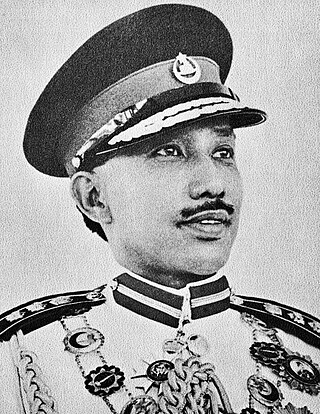
Omar Ali Saifuddien Sa'adul Khairi Waddien was the 28th Sultan of Brunei, reigning from 1950 until his abdication in 1967 to his oldest son, Hassanal Bolkiah.

Omar Ali Saifuddin II was the 23rd Sultan of Brunei. During his reign, Western powers such as the United Kingdom and the United States visited the country. His reign saw the British adventurer James Brooke becoming the White Rajah of Sarawak.
Omar Ali Saifuddin I ibni Muhammad Alauddin, also known as Al-Marhum Makam Besar, was the 18th Sultan of Brunei and the second son of Sultan Muhammad Alauddin. He was regarded as one of the longest-serving sultans and was renowned for his wise leadership and just rule, merely following his father-in-law, Sultan Hussin Kamaluddin. In fact, he received helpful knowledge, counsel, and experience from his father-in-law when he was still alive during his reigning period.

Muhammad Jamalul Alam II was the 26th Sultan of Brunei from 1906 until his death in 1924. He was succeeded by his eldest son Sultan Ahmad Tajuddin.

Bendahara was an administrative position within classical Malay kingdoms comparable to a vizier before the intervention of European powers during the 19th century. A bendahara was appointed by a sultan and was a hereditary post. The bendahara and the sultan shared the same lineage.

Abdul Momin ibni Abdul Wahab was the 24th Sultan of Brunei from 1852 until his death in 1885.

Hashim Jalilul Alam Aqamaddin was the 25th Sultan of Brunei from 1885 to 1906. Pengiran Anak Hashim or Hashim Jalilul was a prominent and controversial figure in Bruneian history. Many Western visitors' narrative painted him and his surroundings in a bad light, which was consistent with the idea that Brunei was a decaying monarchy at the time.
Muhyiddin ibni Abdul Jalilul Akbar was the 15th Sultan of Brunei and the fourth son of Sultan Abdul Jalilul Akbar. He took the throne after defeating his opponent, Sultan Abdul Hakkul Mubin during the Brunei Civil War. Notably, he also attempted to return the throne back to the origin bloodline via Sultan Muhammad Ali's family.
Muhammad Ali ibni Muhammad Hasan, also known as Marhum Tumbang di Rumput, was the 13th Sultan of Brunei. His murder would later go on to spark the beginning of the Brunei Civil War between his killer and Sultan Muhyiddin, which a protracted civil war of succession that broke out and lasted for several years.
Abdul Jalilul Akbar ibnu Muhammad Hasan, posthumously known as Marhum Tua, was the sultan of Brunei. His verified reign of 61 years, make the longest of any Bruneian sovereign.

Pengiran Anak Mohamed Alam was a nobleman, magistrate, and politician who served as the fourth Speaker of the Legislative Council from 1971 to 1974, and as the Chief of Adat Istiadat Negara from 1954 to 1981. A member of the Bruneian royal family, he was the father of Pengiran Anak Saleha, the queen consort of Sultan Hassanal Bolkiah. He was also the maternal grandfather of Al-Muhtadee Billah, the Crown Prince of Brunei.

Pengiran Anak Hajah Besar was a member of the royal family as the wife of Pengiran Anak Mohammad Alam and the mother of Pengiran Anak Saleha, the queen consort of Hassanal Bolkiah, the 29th Sultan of Brunei.

Pengiran Anak Damit was the Queen of Brunei as the wife of the 28th Sultan of Brunei, Omar Ali Saifuddien III.

Pengiran Muda Hashim was a Bruneian nobleman and politician who held several significant positions, including membership in the Privy Council, Legislative Council, and the Brunei Islamic Religious Council. As a member of the Bruneian royal family, he was the husband to Pengiran Anak Puteri (Princess) Besar, the daughter of Sultan Muhammad Jamalul Alam II. He was named Wazir in 1952 and served on the executive committee for the coronation ceremony of Sultan Hassanal Bolkiah, acting as Sultan during the late Sultan's foreign tours.

Pengiran Anak Khamis was a Bruneian nobleman and politician who formerly held several high-ranking positions which included being a member of the Privy Council, and the Brunei Islamic Religious Council. He is the non-gahara son of Sultan Hashim Jalilul Alam Aqamaddin, therefore does not carry the title Prince.

Pengiran Muhammad Salleh bin Pengiran Anak Haji Muhammad was a Bruneian nobleman, religious figure and politician who formerly held several high-ranking positions which included being a member of the State Council, Privy Council, Legislative Council, and the Chief Kadi. He spent practically his whole life fighting for the advancement of Islam and was well-known for being one of the nation's top religious activists.

Pengiran Muda Abdul Kahar was a nobleman and civil servant from Brunei who served as the chairman of the Tujuh Serangkai committee from 1953 to 1954, tasked with gathering the perspectives of Bruneian citizens, both rural and urban, on the proposed Constitution of Brunei, compiling a comprehensive report, and advising Sultan Omar Ali Saifuddien III during its drafting. Additionally, he was the appointed head of the Cheteria from 1951 to 1957.
Muhammad Kanzul Alam ibni Omar Ali Saifuddin I was the sultan of Brunei from 1807 until his death in 1826.
Muhammad Tajuddin ibni Omar Ali Saifuddien I was the sultan of Brunei from 1778 to 1804 and again from 1804 to 1807. He succeeded his father, Omar Ali Saifuddin I, to the throne in 1778, and served until 1804 before abdicating in favor of his son, Muhammad Jamalul Alam I. However, after his son died later that year, Tajuddin regained the throne and served until his death in 1807.





















